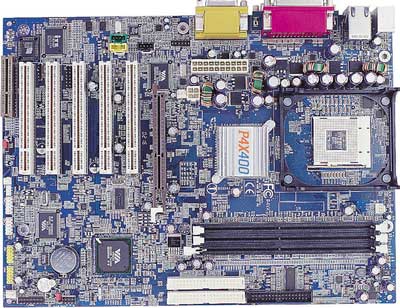VIA and SiS Battle for Supremacy: 3-way P4 DDR Motherboard Roundup
by Evan Lieb on July 30, 2002 2:46 AM EST- Posted in
- Motherboards
VPSD P4PB 400
| Motherboard Specifications |
|
|
CPU
Interface |
Socket-478 |
|
Chipset |
VIA
P4X400 North Bridge VIA VT8235 South Bridge |
|
Bus
Speeds |
100
- 200MHz (in 1MHz increments) |
|
Core
Voltages Supported |
up
to 1.85V |
|
I/O
Voltages Supported |
N/A |
|
DRAM
Voltages Supported |
up
to 2.8V |
|
Memory
Slots |
3
184-pin DDR DIMM Slots |
|
Expansion
Slots |
1
AGP 8X Slot 5 PCI Slots |
|
Onboard
RAID |
N/A |
|
Onboard
USB 2.0/IEEE-1394 |
USB2
Supported through South Bridge |
|
Onboard
LAN |
VIA
Rhine III VT6105 |
|
Onboard
Audio |
VIA
VT1616 6-Channel AC'97 Codec |
VIA decided to design two different P4X400-based motherboards for two separate markets this time around. The first P4X400-based motherboard (the board we’ll be testing today) is called the P4PB 400. VIA’s second P4X400 motherboard is still in the works, dubbed the P4PB Ultra.
While the P4PB 400 isn’t as feature-rich as some of the Intel 845E and 845G boards we’ve tested in the past, it still packs quite an acceptable punch. The P4PB 400 includes support for up to 6 USB 2.0 ports, 2 ATA133 IDE channels, and onboard LAN and sound chips. The P4PB 400 is also quite flexible, with support for as much as 3.0GB of memory using any of the 3 DIMM slots onboard. In addition, there are 5 PCI slots ready for additional expansion.
The P4PB 400 also includes VIA’s onboard VT6306 IEEE 1394 controller. Unfortunately our board was not outfitted with VIA’s FireWire chip for some reason, but we were assured that all future VIA P4PB 400 boards will come with onboard 1394a FireWire.
There isn’t much special to say about the other onboard chips. VIA’s
LAN chip supports a basic feature-set; wake-on-LAN, remote bootability and multiple
VLAN. VIA’s onboard 6-channel sound wasn’t all that terrible either.
Stressing the P4PB
The general reliability and stability of a motherboard is difficult to gauge
in a single review over a matter of days. In fact, one method of measuring reliability
is to examine the individual layers of a PCB by breaking apart a motherboard
and examining the board under a microscope. Obviously, we don’t have the
ability do such a test, so we decided to instead share our more practical stress
test results. We felt that this way our readers will be able to come up with
their own conclusions.
We started stress testing the P4PB 400 by running Prime95 Torture tests around
the clock using DDR333 CL2.5 memory from Samsung. We also ran all the latest
video games to make sure the P4PB 400 could handle intensive DX8 gaming. Finally,
we decided to be a little more aggressive, so we went into the BIOS and adjusted
the memory timings. We switched to Turbo mode and went down to CL2. All in all
though, none of the aggressive timings we used fazed the P4PB 400.
However, some problems cropped up once we started testing DDR400 memory. First off, one of the 3 DIMM slots was completely unable to operate DDR400; it wouldn't even boot into Windows XP. We don’t know the exact cause for this malfunction, but we are working with VIA to pinpoint the issue.
Despite this anomaly, we were able to operate the DDR400 memory in the other
two DIMM slots available on the P4PB 400. With DDR400 in either of the two slots,
we were able to boot into Windows XP and run some of the stress tests and benchmarks
we needed for DDR400 scores. Unfortunately, the P4PB 400 failed to complete
SYSMark 2002 among other benchmarks, even after several tries. But even though
the DDR400 memory was mostly operational using the 2 other slots, it definitely
wasn't as trouble free as we would have preferred (random crashes and reboots
galore).
Overclocking the P4PB
The P4PB 400 comes with a few friendly overclocking options in its BIOS. One of these options lets you raise CPU core voltage as high as 1.85V. While raising Vcore is a good way of ensuring stability when overclocking, you generally don’t want to raise the core voltage more than 10 – 15%, as it can permanently damage your CPU.
Other overclocking options in the BIOS include being able to raise DDR voltage as high as 2.8V, AGP voltage tweaks up to 1.8V, and a 100-200MHz adjustable FSB (in 1MHz increments). Unfortunately there is no option for locking the AGP/PCI bus at 66MHz/33MHz, which is a must for many overclockers.
Though some of the P4PB 400's results might seem quite poor, it’s hard to get a totally accurate picture of stability and reliability when testing a motherboard for a short period of time using only one of the many P4PB 400 motherboards in existence. Over the long haul (months and months of stress testing) you should be able to assess, in general, how stable and how much potential your motherboard is capable of producing, especially if you’re able to test many of the exact same motherboards over the same period of time. We can only share our results as a guide to help you in your decision making process.











0 Comments
View All Comments